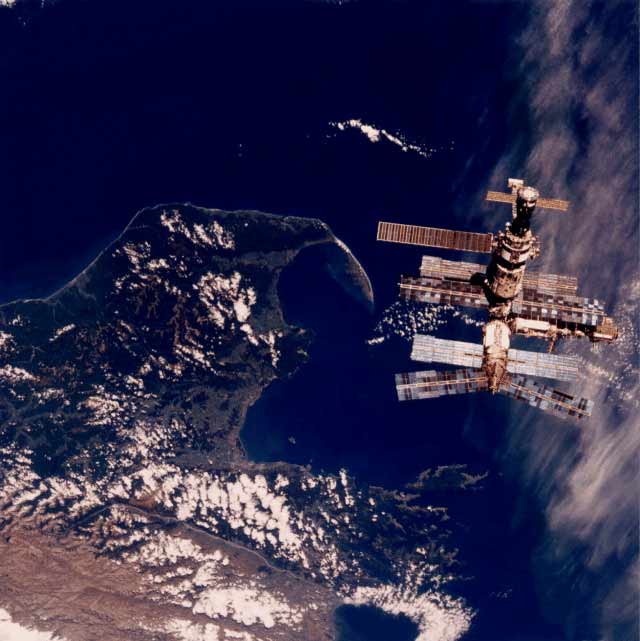Unwanted Life Forms Abound in Sick Spacecraft

Spacecraftstart out clean - as close to germ-free as humans can make them. But afteryears of use, unused spaces within the walls can become home to unwanted lifeforms.
When NASA joined theRussian space program in its evaluation of the microbial activity aboard the Mir spacecraft, they made some interesting discoveries.NASA's plan was to obtain information that would be useful during long-durationmissions.
Mir had suffered severalpower outages during its fifteen years in low earth orbit; temperature andhumidity had gone well beyond normal levels. In 1998, NASA astronauts werecollecting samples from air and surfaces. Imagine their surprise when they openedan obscure service panel in Mir's Kvant-2 Module and discovered a free-floatingmass of water.
"According to the astronauts' eyewitness reports, theglobule was nearly the size of a basketball," C. Mark Ott, healthscientist at Johnson Space Center in Houston, Texas, said.
Following a thoroughsearch, several more globules were discovered. The water wasn't clean, either;two of the blobs were brown and the other was milky white. Samples taken backto Earth for analysis contained several dozen species of bacteria and fungi,plus some protozoa, dust mites (see photo),and possibly spirochetes. The temperature behind the panels was a toasty 82degrees Fahrenheit - perfect for microorganisms.
Colonies of unwantedorganisms were also found growing on rubber gaskets around windows, on spacesuit components, cable insulations and tubing, on the insulation of copperwires, and on communications devices.
In the near future,astronauts won't need to send out the samples to a lab. They will use the new LOCAD-PTShandheld microorganism detector, developed by NASA to give results in justten minutes.
Get the Space.com Newsletter
Breaking space news, the latest updates on rocket launches, skywatching events and more!
Microorganisms can pose areal hazard to the health of a spacecraft. According to Andrew Steele, seniorstaff scientist at the Carnegie Institution of Washington working with otherinvestigators at Marshall Space Flight Center:
"Microorganisms can degrade carbon steel and evenstainless steel. In corners where two different materials meet, they can set upa galvanic [electrical] circuit and cause corrosion. They can produce acidsthat pit metal, etch glass, and make rubber brittle. They can also foul air andwater filters."
Science fiction authorshave worried about unwanted alien life forms in spacecraft for years. In his1985 novel Schismatrix,sf author BruceSterling wrote about "sours:"
Each Concatenate world faced biological problems as itaged...
TheRepublic struggled to control its Sours...Mutant fungi had spread like oil slicks,forming a mycelial crust beneath the surface of the soil...
(Read more about sours)
Ten years earlier, rat-sizedaliens with inborn engineering skills destroyed a spacecraft from withinthe walls in The Motein God's Eye, by Larry Niven and Jerry Pournelle.
In the 1960's, the problemwas addressed humorously in The Trouble with Tribbles, a classic StarTrek episode written by sf author David Gerrold, first broadcast on June 21,1968. Storage bins on Deep Space Station K7 are being used to storequadro-triticale, a bio-engineered grain. Irresponsible entrepreneur CyranoJones brings cute furry animals called tribbles onto the station. It turns outthat tribbles get into everything, and have a spectacular rate of reproduction(according to Dr. McCoy, "they're born pregnant"). The station issoon shoulder-deep in tribbles (see photo).
What are your favoritealiens hiding in the walls of spacecraft? Read more at Science@NASA.
(This Science Fiction inthe News story used with permission from Technovelgy.com - where science meetsfiction.)
Join our Space Forums to keep talking space on the latest missions, night sky and more! And if you have a news tip, correction or comment, let us know at: community@space.com.
Bill Christensen is the founder and editor of Technovelgy, a website dedicated to cataloguing the inventions, technology and ideas of science fiction writers. Bill is a dedicated reader of science fiction with a passion about science and the history of ideas. For 10 years, he worked as writer creating technical documentation for large companies such as Ford, Unisys and Northern Telecom and currently works to found and maintain large websites. You can see Bill's latest project on Twitter.









